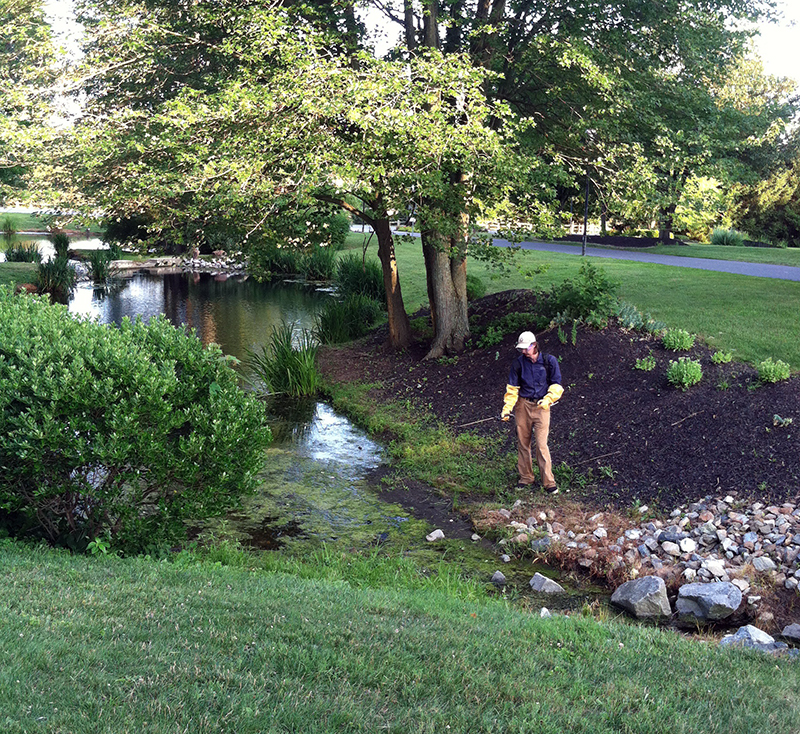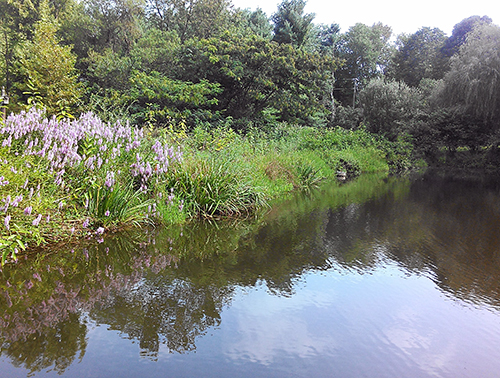Nuisance Algae and Aquatic Weeds: Promoting Pond and Lake Health
July 1st, 2014
Written by Industry Expert Gavin Ferris, Ecologist
 While I was using my backpack sprayer to treat a particularly offensive pond algae bloom on community property, a woman came up to me in a highly agitated state. The next thing I knew, I was being read the riot act for spraying “poison” into the water where she walks her dog, and where children play. I explained to her that the pond algae I was treating had the potential to release toxins if left untreated, that it could deplete the oxygen in the water and cause a fish kill, and that the product I was using had undergone rigorous testing for environmental safety. In the end she agreed that it was better for me to treat the algae than to leave it alone, but she still was not happy about it. I told her I was not particularly happy about it either.
While I was using my backpack sprayer to treat a particularly offensive pond algae bloom on community property, a woman came up to me in a highly agitated state. The next thing I knew, I was being read the riot act for spraying “poison” into the water where she walks her dog, and where children play. I explained to her that the pond algae I was treating had the potential to release toxins if left untreated, that it could deplete the oxygen in the water and cause a fish kill, and that the product I was using had undergone rigorous testing for environmental safety. In the end she agreed that it was better for me to treat the algae than to leave it alone, but she still was not happy about it. I told her I was not particularly happy about it either.
My philosophy has always been to treat pesticides the same way you treat antibiotics. This is a useful way to think about the products we use as both are a chemical formula designed to kill certain unwanted organisms. Just like antibiotics, pesticides should only be used when they are the best tool for the job. Often they are the only tool available to solve some problems. Misuse of them can be damaging on its own, or could lead to resistance in the target organisms. Therefore, when other solutions are available they should be utilized to the greatest extent possible. As always, an ounce of prevention is worth a pound of cure.
Preventing nuisance algae and aquatic weeds in ponds is a lot like preventing infections in people. In both cases most infections can be prevented with balanced nutrition, a strong respiratory system, and a healthy community of symbiotic microbes.
Think about how your diet affects your health. If you have too many calories, too much cholesterol, not enough vitamins, and so on, you will get sick more often. We might want to eat nothing but bacon, but I’m pretty sure that would result in some major health problems. Similarly, if a pond is receiving too much Phosphorus, too much Nitrogen, and not enough alkaline minerals, undesirable aquatic vegetation and algae will proliferate.
 Persistent algae growth is usually a symptom of unbalanced nutrient levels. Establishing a beneficial vegetative buffer around the perimeter of a pond can help, but sometimes nutrients like Phosphorus can be so far above healthy levels that the application of nutrient-binding products like Phoslock are required to keep those nutrients from fertilizing unwanted algae and weeds. Every pond is different, so monitoring water quality and sediment chemistry through periodic testing will help to develop a nutrient management strategy that works for you.
Persistent algae growth is usually a symptom of unbalanced nutrient levels. Establishing a beneficial vegetative buffer around the perimeter of a pond can help, but sometimes nutrients like Phosphorus can be so far above healthy levels that the application of nutrient-binding products like Phoslock are required to keep those nutrients from fertilizing unwanted algae and weeds. Every pond is different, so monitoring water quality and sediment chemistry through periodic testing will help to develop a nutrient management strategy that works for you.
Ponds breathe just like we do. Atmospheric gasses dissolve into the water, providing oxygen that allows all the microbes, plants, and animals to respire. If your respiratory system is impaired, you are more prone to infection. Likewise, if your pond doesn’t get enough dissolved oxygen, lots of bad things can happen from algae blooms and toxic bacteria to hypoxia and fish kills. The addition of a pond aeration system or fountain to more efficiently supply the aquatic ecosystem with dissolved oxygen is almost always well-advised, and in some cases is a crucial component in a comprehensive pond management plan.
An adult human body has somewhere in the neighborhood of 10-50 trillion cells making up our muscles, skin, bones, nerves, and the rest of us. The typical human also contains well over 100 trillion microbes in their digestive system; well more than the number of cells making up the body itself. Without this complex community of hundreds of species of bacteria and fungi, we could not survive.
The sediment and deep water of your pond is essentially its gut. This is where bacteria digest nutrients into biologically available forms and send those compounds on up the food chain. Insufficient microbial biomass, or the wrong balance of bacteria, can lead to persistent algae problems. There are a number of pond bacteria formulations available on the market designed for a variety of ecological conditions, and many ponds benefit from infusions with these beneficial microorganisms.
One more action we can take to prevent algae and weeds from reaching a point at which chemical treatment becomes necessary is the application of blue and/or black pond dye. By darkening the water, we limit the amount of sunlight available for plants and algae. It also just happens to look very nice.
Even healthy people get sick sometimes. The same is true of ponds. We can make a pond less susceptible to algae and aquatic weed outbreaks by improving its overall health.
Just as not every disease can be prevented or treated with diet and exercise, not every weed or algae inundation can be prevented or mitigated through non-chemical means. When treatment does become necessary, however, aeration, nutrient management, and biological mitigation all help to make treatments more effective.
Newer, safer, and more effective algaecides and herbicides are being developed all the time, and they will always be a vital tool in maintaining our aquatic ecosystems, but it is in everyone’s best interest to take every action possible to improve biological health and limit the necessity of pond treatment.
Find Your Water Quality Solution
Contact the experts at 888-480-5253 for all of your lake, pond and fisheries management needs.
Gavin Ferris is an Ecologist with SOLitude Lake Management. Since 1998, SOLitude Lake Management has been committed to providing full service lake and pond management services that improve water quality, preserve natural resources, and reduce our environmental footprint. Services are available throughout the Eastern United States. Fisheries management consulting and aquatic products are available nationwide. Learn more about SOLitude Lake Management and purchase products at www.solitudelakemanagement.com.










